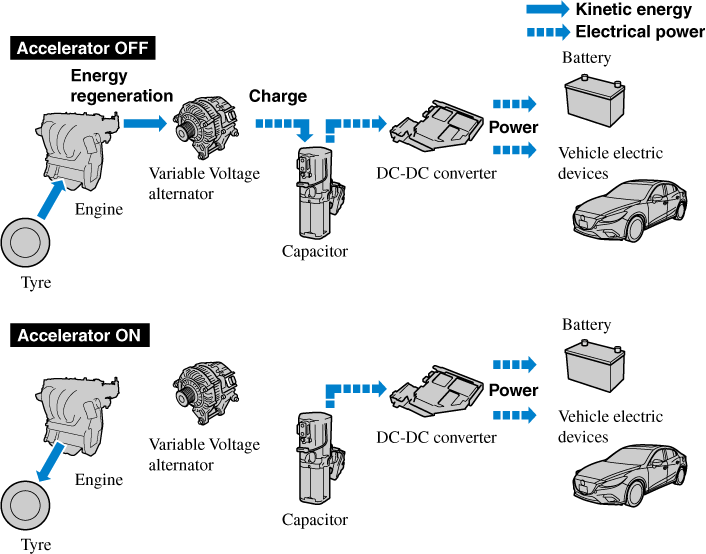Better fuel consumption, reduced impact to environment, these are some of the promises of driving a hybrid car. But after more than 8 years of driving Mazda 3 2.0L model, with 2 failed capacitors after a mileage of 60,000 km – and they are expensive to replace (S$2k or US$1.5k each) – I’d rather drive a regular car. Here is why.

Mazda implements hybrid with a similar concept 10 years ago and now. Energy is recovered while braking, stored into a capacitor (which is able to store energy much faster than a battery), and deploy the energy to power the car electronic accessories and/or charge the regular battery. This design also comes with idling stopping (i-Stop), which as a driver, it is a pain to use. And I will get into that in just a bit.
The older design called i-ELOOP does just that (see below). The newer design called M-Hybrid or Mild-Hybrid improves upon i-ELOOP. M-Hybrid also provides motor assistance, amongst other minor benefits such as quiet engine restart.

This design does very little during smooth highway driving. Because maintain speed won’t charge the capacitor. It works well in city driving when there are frequent stop-and-go. Idling stop or i-Stop is optional. If you don’t like it, you have to turn it off manually every time you start the car.
There are a few reasons why I don’t like i-Stop. To activate i-Stop, I have to press pretty hard onto the brake. The moment I let go the brake even slightly will turn the engine back on. It can get tiring at the traffic lights. I could put the handbrake on (my usual practice at a traffic light) but in order to activate i-Stop without pressing onto the brake harder than usual, I have to put my car on neutral.
What I least like about i-Stop is that at the junction especially on a slightly down slope, I may have to briefly stop the car and observe the traffic before joining the main road. If I press the brake too hard, the engine will stall thanks to i-Stop. I’ll have this brief moment when my car has no power and I want to move.
Over these 8 years, I have countless number of hours on the road to reflect on this terribly bad design and how this can be improved (and I really want to speak with the design team). I can’t think of a smarter solution. Not until the car is able to self-drive and obviously, by then, the car should know when to turn off its engine. The only thing I can think of is perhaps having a button at the wheel to signal my intention to stop the engine when the vehicle next comes to a complete stop. And I should be able to cancel my intention due to changing road conditions. The engine should restart when I press the gas pedal or in motion again.
I do not know if capacitor’s degradation is due to time or mileage or both. If I am to change the capacitor every 5 years – depending on when you scrap or sell your car – I am 100% sure the cost saved on petrol isn’t worth it. According to a study in Australia, at best I’d save a full tank of petrol per year thanks to i-Stop. 5 full tanks of petrol can’t even pay for a capacity replacement that can cost S$2k (or US$1.5k). There are cheaper options (up to 30%) such as a used capacitor or outside Mazda workshop. But it comes with pros and cons. Also, while one could argue that lesser emission means better for the environment, I would argue that manufacturing and disposing these capacitors would have a negative impact to our environment.
What if you don’t change the faulty capacitor? Like me (since I may scrap the car when 10 years is up – note: in Singapore, to drive a car beyond 10 years requires another 10-year certificate of entitlement that may cost more than S$100k)?
Your car may start to vibrate. The battery may degrade faster. The alternator may fail. Other electronic components may start to fail. Turning off i-Stop just means the car will not stop when idle. And there is no way to bypass the entire hybrid design. I wish there was one.
What about the newer Mazda M-Hybrid design? I reckon more car parts means more parts need servicing or replacement over time. I hate the i-ELOOP implementation. I doubt I will like M-Hybrid. Though the newer Mazda hybrid models probably has a 5-10% better fuel efficiency (note: hard to compare as they don’t sell a Mazda 3 here in Singapore with a 2.0L engine).
Nah. Not worth it.
There is no business case here. Just useless sales pitch.